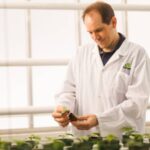Photoperiodic vs. Photosynthetic Lighting
A common question I’m asked is what the best lighting strategy is to promote early spring flowering of bedding plants and/ or herbaceous perennials. The answer to such a question is situational, depending in part on the crops being grown, the stage of production (transplant stage or finish stage), whether they currently utilize electric lighting and their growing location. Table 1 compares photoperiodic and photosynthetic lighting.

Table 1. Comparisons between delivering photoperiodic and photosynthetic lighting to a broad range of greenhouse-grown crops.
Low-intensity (photoperiodic) lighting regulates flowering. Photoperiodic lighting is the delivery of low-intensity lighting to create long days when the days are short. The typical intensity delivered is 1 to 2 _molám-2ás-1, which is bright enough for plants to perceive but not enough for photosynthesis. Therefore, photoperiodic lighting is only used to accelerate flowering of long-day plants and inhibit flowering of short-day plants; it does not increase growth. The simplest way to deliver photoperiodic lighting is by installing screw-in fixtures (with LED or fluorescent bulbs) spaced every 6-10 feet, depending on the light output. Fluorescent lamps, red LEDs and white LEDs can be effective to inhibit flowering of short-day plants.
In contrast, lamps that emit red and far-red light are usually the most effective at promoting flowering of a wide range of long-day plants, especially when the daily light integral (DLI) is low.
The primary application of photoperiodic lighting is after transplant and when the natural day length is short. For spring-finishing crops, that usually means lamps are operated from January to early April. Once the natural photoperiod is long, there is no value of photoperiodic lighting and so lamps should be turned off.
High-intensity (supplemental) lighting increases growth. Photosynthetic lighting delivers a much higher intensity, typically around 50-75 _molám-2ás-1, but even higher intensities are used on high-wire vegetable crops. This type of lighting increases photosynthesis and during periods of low light, it can accelerate rooting and increase stem diameter, branching and flower number of ornamentals.
Plugs and liners that are lighted typically flower earlier, sometimes by as much as one to two weeks. However compared to photoperiodic lighting, it is much more expensive to install and operate, so its use is generally on high-value crops such as plugs and liners, and on crops when the harvestable yield increases with light quantity such as fruiting vegetables and cut flowers. High-inten- sity lighting is rarely used after transplant of ornamentals because of its expense on a per-plant basis.
When lighting is only used part of the year (three or four months), high-pressure sodium (HPS) lamps with electronic ballasts are often the most economical light source when growing ornamentals. However, the best LEDs are now more efficient than the best HPS lamps while the cost of LEDs continues to come down, making LEDs increasingly cost competitive.
Photosynthetic lighting can also be used to create long days, either by operating all lamps or a small subset (e.g., 10 percent) of them. There’s no need to have both lighting systems in the same greenhouse space.


 Video Library
Video Library 




















